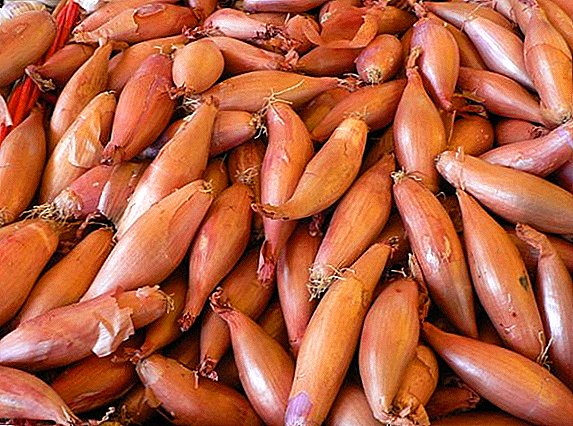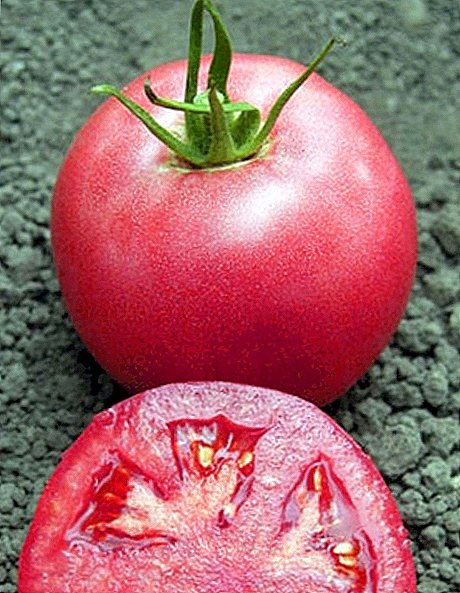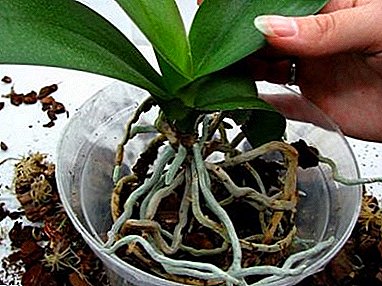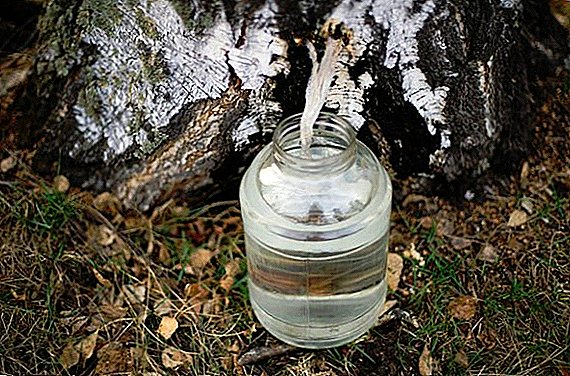 Of all the flowering abundance of room vegetation, many growers prefer streptocarpus. These bright multi-colored flowerpots are of interest not only for their unusual deep color, but also for their abundant long flowering, ease of planting and care. We will understand in more detail what a streptocarppella flower needs for full-fledged vegetation at home, how to propagate it and extend its flowering.
Of all the flowering abundance of room vegetation, many growers prefer streptocarpus. These bright multi-colored flowerpots are of interest not only for their unusual deep color, but also for their abundant long flowering, ease of planting and care. We will understand in more detail what a streptocarppella flower needs for full-fledged vegetation at home, how to propagate it and extend its flowering.
Botanical description
In the scientific literature of these herbaceous rosette representatives of the Gesneriev family, they are called "streptocarpus" and "streptocarpellas", and in the people they are designated by the abbreviated "strep".
Did you know? The name of a flowerpot of ancient Greek origin, in translation means "twisted in a box". It is caused by the specifics of the seeds, which, when ripe, are wrapped inside.
Externally, the plant is a low leafy rosette with short, heavily pubescent stalks. Powerful flower stalks with bright buds appear in its core.
When they fully open, the flowers resemble bells. Petals are often heterogeneous in color and shape, they can be decorated with fringe, various specks, banding, terry, corrugations and intricate bends.  The foliage at the flowerpot is large and fleshy with clear veins, which gives it a slight wrinkling. The middle leaf plate is about 7 cm wide and 15 cm long, but there are twice as many specimens.
The foliage at the flowerpot is large and fleshy with clear veins, which gives it a slight wrinkling. The middle leaf plate is about 7 cm wide and 15 cm long, but there are twice as many specimens.
Blue, purple, mauve, white velvety petals look very impressive against a dark green saturated background. The main secret of the plant lies in the abundant intensive flowering - with one outlet at the same time up to hundreds of peduncles can appear. Isn’t flower growers dreaming about this?
In the wild, the plant is found on the coasts of Madagascar and South Africa, but, despite its tropical origin, it easily develops in apartment conditions.
Did you know? Streptokarpella came to Europe thanks to the famous botanist James Bowie, who discovered a unique flower 200 years ago while traveling. Then it was called Didimocarpus rexii, but over time it was renamed Streptocarpus rexii.
Today, scientists have more than 130 types of streptocarpus, and breeders in recent years have multiplied their thousands of hybrids, which can turn the head of even the most indifferent to plants plants of society. 
Choosing a place for a flower
With the room maintenance of a tropical guest, it is necessary to create conditions as close as possible to the relatives. To do this, it is important to take into account the temperature, humidity in the room, lighting, the composition of the earth mixture, and even the size of the pot for planting a flower.
The Gesneriev family also includes episia, achimenes, kolery, eschinantus, gloxinia.
It is only at first sight that streptokarpella seems capricious, but in fact its cultivation has much in common with the synpolies and does not require extraordinary efforts or supernatural knowledge. We will understand everything in order.
Air humidity and temperature
Perhaps this is one of the key requirements of a thermophilic flower. For its development, it is important that the room is warm and humid. During the period from spring to October, when the flowerpot is in bloom, the optimum air temperature in the room should vary between + 22 ... +24 ° C, and in winter, when streptokarpus goes into hibernation, it will be arranged by reduced indicators of the thermometer to +15 ° C for ordinary and up to +18 ° C for hybrid varieties. 
Important! Typically, streptocarpus bloom for half a year in indoor conditions. You can extend this pleasure by highlighting a pot with fluorescent lights in the winter. Then the motley buds will not get off the velvety leafy rosette for a year.
In the hot season, the foliage of a flower often loses its decorative effect and wilts. To correct the anomaly can only increase the humidity in the apartment. This is the first sign of the wrong content of a green pet.
For its comfort, it is important to provide a moist atmosphere, but standard spraying is not suitable in this case. The fact is that a plant, like violets, reacts painfully when water gets on the foliage.
Therefore, experts recommend near the pot to put a container with water. This could be a wet clay pan, a vase or even an aquarium. 
Lighting
Streptokarpelly prefer eastern and western window sills, where there is always a lot of light. But keep in mind: they will not have the liking of the sun. Therefore, do not expose the culture under direct sunlight, and if necessary shade the windows.
For full development and abundant flowering streptocarpus requires 14-hour daily coverage.
Soil type
The quick growth of the pot will provide a well-chosen substrate. First, it should be light and loose. Secondly, with a neutral acid reaction. And, thirdly, it is good to pass moisture and air.
Important! The pot for streptokarpelly need to choose a wide and shallow, because in the wild nature, these magnificent plants grow on the rotten bark of fallen trees.
To satisfy all these whims, experts advise to buy special soil mixtures, and before planting the plants, cover the bottom of the container with a 2-centimeter ball of expanded clay. Some gardeners supplement the purchase substrate with sphagnum moss, perlite, peat, vermiculite.  If you dare to prepare the substrate yourself, stock up with 1 cup of crushed charcoal and equal parts of top peat, perlite, coniferous humus and chernozem. Young instances can not add the last component.
If you dare to prepare the substrate yourself, stock up with 1 cup of crushed charcoal and equal parts of top peat, perlite, coniferous humus and chernozem. Young instances can not add the last component.
Rules for the care of streptocarpella
When growing at home, streptokarpella requires a bit of attention and elementary care, so with the help of a photo we will teach you how to properly organize it and analyze vital aspects for a flower.
Watering
This mysterious Madagascar exotic loves moisture, but does not tolerate its excess. Experienced growers ensure that water does not fall on the plant during humidifying procedures, especially in the core of the outlet.
Watering is carried out at the edges of the pot exclusively with a watering can with a long curved spout. Water defended without fail and give it the opportunity to warm up to room temperature.
Did you know? The variegated forms of streptocarppelle first appeared in the United States of America thanks to the breeder Michael Ketuzu, who 5 years ago launched a whole breeding series of wonderful variegates called "Iced."
The number of waterings per week depends on the state of the earth in the pot. The flower is drought-resistant, so periodic drying will benefit only. In this case, it is better to overdry, rather than pour. In addition, short-term drying of earthy coma will prevent the development of pathogens of fungal and bacterial diseases. With the stagnation of water in streptokarpus, in the first place, the root system suffers. As a result, through its decay, the pot is killed.
Do not be alarmed with a slight wilting of foliage. To restore the plant really by intensive soil moistening. In this case, you will need to water the roots every 3 hours.
Top dressing
In order for the indoor pet to enjoy endless flowering and beautiful healthy foliage, it is important nitrogen, potassium and phosphorus. For young seedlings, these components are bred in equal shares, and for mature ones they increase the dose of phosphorus-potassium mixture.
Important! In the absence of daylight, in winter, streptokarpus not fertilize.
The more often you feed a flower, the more intensively it will increase biomass, on which the number of buds directly depends. Experts advise weekly watering strep nutrient mixture, each time reducing the dosage of the constituent components. 
Transfer
The change of the pot and the substrate, these representatives Gisnerievyh only welcome. But it is recommended to carry out transplants only to the extent necessary. The procedure needs to be planned in February, before the beginning of the growing season, and do not forget that only strongly expanded specimens with large leaves and a rosette are exposed to it.
For such samples, containers are sought that are 2-3 cm lighter in diameter than the previous one. At the same time, the width of the pot should be one and a half times greater than its depth.
The flowerpot is well watered and, when the water is completely absorbed by the roots, they roll over along with the earthy ball into a new vessel. Just remember to cover the bottom with a drainage layer. The free space is filled with fresh soil, watered, tamped and lay the top layer of peat moss-sphagnum. 
Breeding methods
Getting new strep seedlings is not as easy as violet. But, if you make a little effort and apply agronomic knowledge, it is quite realistic at home. We will understand what the florist should know and be able to do.
The most elementary and easy method of reproduction is considered by many to be the division of the root of a mature flowerpot during its transplantation. Whether a particular instance is suitable for such a manipulation can be determined by the presence of several bushes in a pot.
In this case, take into account that taking away from the mother sample of children, you impoverish the pomp of its flowering. The buds will badly tie, so do not allow strong thickening.
To divide the rhizome should be disinfected in a manganese solution with a sharp knife. First of all, shake the ground from the roots, and then cut them into pieces according to the points of growth. Before planting, it is advisable to sprinkle the cuts with wood ash. 
Did you know? Giants in the world of streptocarpus are considered to be the varieties "Gillian", "Christmas Morning", "Moonlit Velvet". Their flowers are striking 10 cm in diameter, and foliage - half a meter in length.
Another technology of cultivation of this culture is rooting of the leaf or any of its fragments, which has a length of at least 2 cm. To this end, take a small plastic cup with a layer of drainage and the corresponding substrate, as well as planting material.
Landing is made to a depth of 1 cm. The container should be covered with polyethylene and be sure to put in a warm place. New shoots seem in a month. Multiply streptokarpella possible and seed method. It is chosen by experienced craftsmen with a baggage of special knowledge, since there are few chances for beginners. To obtain the grains, you will need 2 pot, you can of different types and varieties. A few months after their pollination, the seeds begin to ripen.
Its contents are best sown in peat tablets. They are placed in a plastic container and moistened. After the material swells, we deepen the seed, cover it with an identical container and send such a "greenhouse" to a well-lit window sill or under artificial lamps.
Do not place containers in direct sunlight - high temperatures and accumulated condensate will destroy the seedlings.
Did you know? In the wild, some types of streptocarpus live exclusively on rocky areas, while others live on trees. However, they are not parasites.
 Some housewives are preparing a substrate of sodden peat tablets, shaking out the contents of the reticulum. In such cases, the emerged shoots will have to dive twice. Flowers appear on them only after 9 months.
Some housewives are preparing a substrate of sodden peat tablets, shaking out the contents of the reticulum. In such cases, the emerged shoots will have to dive twice. Flowers appear on them only after 9 months.To get a new process of strep can be done by pinching its sheet. The cutting with this method of reproduction does not tear off, but makes a small cut on it and tilts it to the ground. After a month and a half from the place of the cross section, young leaves will appear.
Are there any pests and diseases?
Unfortunately, not only people feel sympathy for delightful colors. Spider mites and thrips love to eat their juice. Also, the plant can infect late blight, powdery mildew, and gray rot.
To prevent the development of large colonies of pests and pathogens, regularly inspect the outer and inner sides of the leaves. Do not allow overmoistening and overheating of the flower.
If symptoms of thrips are found, it will be necessary to remove all flower stalks, regardless of their degree of development, and to treat the outlet with any insecticide ("Fitoverm", "Spintor", "Aktara", "Aktellik"). These drugs will help get rid of other sucking parasites. For the final victory over them will need 3 sprinkles at intervals of 7 days.
Important! To get rid of spider mites in the initial stages can be using soapy water.
 The emergence of fungal mycelium, viruses and bacteria is caused by abrupt temperature changes, prolonged stagnation of water in a flower pot, a rosette deeply immersed in the soil, cold irrigation and compacted soil. Save the affected specimens with fungicides ("Fitosporin", "Skor", "Topaz", "Faktofit").
The emergence of fungal mycelium, viruses and bacteria is caused by abrupt temperature changes, prolonged stagnation of water in a flower pot, a rosette deeply immersed in the soil, cold irrigation and compacted soil. Save the affected specimens with fungicides ("Fitosporin", "Skor", "Topaz", "Faktofit").In addition, when transplanting a flowerpot to a new substrate, it is desirable to add drugs "Barrier" or "Barrier". They help the roots to resist the gray rot.
Sick plants must be isolated from other indoor pets, remove the affected areas and treat them. If you cannot achieve the desired result, pinch off a healthy, strong leaf and try to grow a new streptocarpus out of it.
This mysterious flower will thank you for half a year for elementary care and a drop of attention, and if you try a little more, you will get double gratitude.












